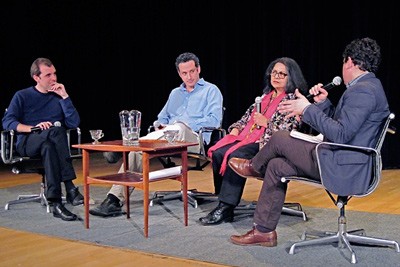Spices were an early engine of globalization, says Tagliacozzo on New York City panel
By John Mikytuck
"Dating back to Asian spice trading routes around 200 B.C., globalization began long before the Internet," said Eric Tagliacozzo, Cornell associate professor of history, at a Jan. 14 panel discussion at the American Museum of Natural History (AMNH) in New York City.
Tagliacozzo and two other experts discussed food's ubiquitous role in the economic, political and social development of the world, from battles over spice trading routes in the first millennium to tea wars in the second, before a capacity crowd. Moderated by Sasha Issenberg, author of "The Sushi Economy," the panel was part of Traveling the Silk Road: Ancient Path to the Modern World, AMNH's exhibition on trade routes joining Mediterranean, African, Middle Eastern and Asian civilizations 2,000 years ago, a period dominated by India and China.
"The idea that spices were used as a preservative in the ancient world is a myth," said panelist Tom Standage, author of "An Edible History of Humanity" and business affairs editor of the Economist. "In ancient times, spices were valued as a symbol of wealth and power."
However, "India was not always the spice capital of the world," said panelist and culinary expert Julie Sahni, author of "Classic Indian Cooking." Before 500 B.C., "India had only three indigenous spices: black pepper, cardamom and turmeric." What people commonly think of as Indian curry is actually from the Mediterranean. "India has always been good at absorbing other's influences and making them her own," said Sahni.
Other foods have had a strong influence on the geopolitical development of the world more recently, noted the panelists. In the 1800s, when British businessmen no longer wanted to trade English silver bullion for Chinese tea, England began using a more debatable product that the Chinese did eventually want, which was poppy seeds for opium, said Standage. When Chinese officials realized what opium imported from British traders was doing to their population, they attempted to halt trading. The result were the Opium Wars between China and Britain (1839-1842 and 1856-1860). China lost both and was forced to cede Hong Kong to England.
The palettes and profits of the wealthy and powerful have also played a significant role on the consumption and development of certain foods throughout history, according to the panelists. "There is strong evidence to suggest that elites were the taste-makers of history," said Tagliacozzo. "Cloves found in the tombs of Han Dynasty princes in the first millennium offer just one example." Today, bird's nest soup, literally made from swallow nests and considered a delicacy among wealthy Chinese dating back hundreds of years, is still served as a status symbol at middle- and upper-class Chinese weddings, he said.
And an example of the influence of political power on foods can be found in sushi. "At one point," said Issenberg, "the fatty parts of sushi were considered less appealing by most Asians and discarded. Then, after the U.S. victory over Japan by steak-loving Americans in World War II, fatty sushi became a prized delicacy."
Interest in the flavorful past of China and India seems to be growing as both countries re-emerge as driving forces of the world's economy, said the panelists.
"There was a time when Chinese officials mostly came to America to meet with university presidents," said Tagliacozzo after the event. "Today, U.S. university presidents also travel to Asia to meet with Chinese officials."
John Mikytuck '90 is a freelance writer in New York City.
Get Cornell news delivered right to your inbox.
Subscribe